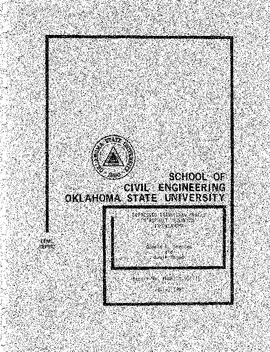| dc.creator | Snethen, Donald R. | |
| dc.creator | Ahmed, Samir | |
| dc.date.accessioned | 2018-10-15T15:24:13Z | |
| dc.date.available | 2018-10-15T15:24:13Z | |
| dc.date.issued | 1991-7 | |
| dc.identifier.govdoc | FHWA-OK-91-__ | |
| dc.identifier.other | Oklahoma Department of Transportation State Planning and Research item number 2159 | |
| dc.identifier.uri | https://hdl.handle.net/11244/301823 | |
| dc.description.abstract | Transverse cracking of asphalt pavements is a costly pavement distress occurring in states that experience cold/freezing temperatures during the winter months. The cracks are causedˆ by low temperature-induced tensile stresses that exceed the tensile strength of the pavement material. The majority of these cracks occur in the transverse direction relative to the pavement and with regular frequency along the roadway. The major objectives of this research included: 1. Determine the nature and extent of transverse cracking in asphalt pavements in Oklahoma. 2. Conduct a field and laboratory investigation of pavement m ateri als and highway features to determine and evaluate the various factors that influence transverse cracking. 3. Review ODOT practices for dealing with transverse cracking of asphalt pavements. The results of the research project confirm that the transverse cracking of pavements is a thermally-induced problem. Based on evaluation of collected data, the number of cracks increased and the average spacing decreased as the average low monthly temperature decreased. Depressions associated with transverse cracks were influenced by subgrade moisture conditions; specifically, as the average subgrade moisture content increased, the occurrence and severity of the depressions increased. Transverse cracking and particularly depressed transverse cracks appear to be more of a problem on fine-grained soil subgrades. Transverse cracking of asphalt pavements is a problem across the state of Oklahoma with severity of the problem varying from division to division based on such factors as pavement age, pavement cross section, traffic, asphalt properties, and maintenance procedures. Although maintenance and remedial procedures vary across the state, ODOT's procedures are consistent with those reported by surrounding states. | |
| dc.format.extent | 72 pages | |
| dc.format.extent | 21,679,750 bytes | |
| dc.format.medium | application.pdf | |
| dc.language | en_US | |
| dc.relation.ispartofseries | No | |
| dc.relation.requires | Adobe Acrobat Reader | |
| dc.title | Depressed transverse cracks in asphalt pavements in Oklahoma (FHWA-OK-91-__) 2159 | |
| dc.type | Technical Report | |
| dc.description.version | Final Report February-September 1988. September 1988-July 1991. | |
| dc.description.peerreview | No | |
| dc.type.material | text | |
| dc.subject.keywords | Asphalt Concrete | |
| dc.subject.keywords | Asphalt Pavement | |
| dc.subject.keywords | Thermal cracking | |
| dc.subject.keywords | Transverse cracking | |
| dc.subject.keywords | Pavement thickeness | |
| dc.subject.keywords | Depressed transverse cracks | |
| dc.contributor.sponsor | Oklahoma Department of Transportation. Materials and Research Division. Office of Research & Implementation | |
